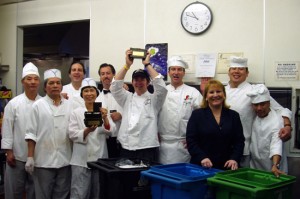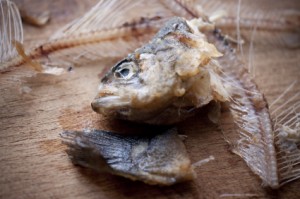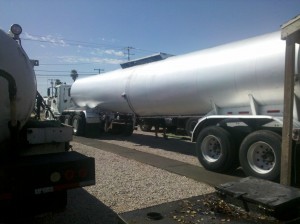By Laurie Wiegler
For some chefs, throwing out a whole carrot is out of the question. They don’t need a lecture about the world’s hungry to act with a conscience as they cook. Yet in America, there are few guidelines that require chefs and restaurant owners to do the right thing, let alone the green thing.
Too few regulations mean it’s up to the responsible chef to use all food products whenever possible, eliminate waste with portion sizes and be mindful about expiration dates – and even this means knowing when “expired” isn’t necessarily spoiled.
According to the National Restaurant Association, which runs a green web site called Conserve, dining establishments are in a unique position to eliminate some of this waste by recycling, reusing and reducing their food and non-food products.
Even so, it’s impossible to know exactly how much food is wasted in US restaurants, so we tapped sources from Hawaii to Illinois to the Carolinas – including a book author and a French chef in Honolulu – to try to find out.
The Whole Fish
Chef Nico Chaize of Nico’s Pier 38 says that discards are few in his kitchen. This is the way of the Japanese and the French, according to this Lyon transplant to Honolulu. “Cooking oil is recycled by the same company that picks it up from me and they use it for biofuel,” he says.
At Nico’s, carrot, celery and onion peels as well as fennel stems go into the broth; while fish bones, fish scraps, meat scraps and chicken bones are also used in soups.
“For the fish – the whole fish, not [a] fillet – you get about 30 to 40 percent waste,” says Chaise. “And that waste, [meaning] the bones, head, things like that – I try to recycle as much as I can. I take bone[s] from tuna, scrape the meat out, scrape meat off the bone and use it to make dishes [such as] ahi tuna bowls.”
At Scoma’s in San Francisco, Executive Chef Alan Fairhurst now uses fish scraps as well, but in a great lobster bisque. “This is what would have been garbage, and we’re making a nice profit from it,” he says.
Cooking with Grease
Cooking oil is one of the biggest issues for restaurants in terms of cost and disposal. Each year, about 2.6 billion gallons of used cooking oil is generated in the U.S., according to GreenMuze. It is reused and disposed of in various ways, most promisingly as an additive to make biofuels.
In Arizona, a company called Green Dining Network actually removes WVO (waste vegetable oil) from member restaurants at no cost and partners with Amereco Biofuels to produce a usable diesel fuel.
Scoma’s uses some of its oil waste to fuel their “Veggie-mobile” and what’s left goes to the nearby Golden Gate Bridge to power maintenance trucks and equipment. Total oil waste for the restaurant is roughly 90 gallons or 700 pounds of vegetable oil each week.

Chef Alan Fairhurst and staff show off the award they received for composting and recycling 95 percent of their waste.
Scoma’s — which is also located in Sausalito — claims to divert 95 percent of its city restaurant waste from landfills via composting and recycling, and because of this has received numerous accolades including “Golden Dumpster” awards from San Francisco’s Department of the Environment as well as state Waste Reduction Awards.
Fairhurst, a 1988 graduate of the California Culinary Academy, says the restaurant’s green approach has evolved since it opened in 1965.
“This is what would have been garbage, and we’re making a nice profit from it.”–Alan Fairhurst
“I think the attitude down here changed in the early ‘70s. I have only worked here since ‘99, but [even] then we had already embarked on a major changing of guard [which occurred] in the late ‘70s and early ‘80s, when we got a lot of fresh blood in the restaurant. [With an influx of young people came] a more idealistic, more energetic [approach].”
Fairhurst says they saw what was going on in San Francisco – which he calls a unique microcosm in the social responsibility arena – and that was an atmosphere in which “it was impossible for McDonalds to sell [burgers] in Styrofoam.”
Then too, there is the other imperative: profits.
Bobby Fitzgerald runs the Naperville, IL White Chocolate Grill and he says waste is “absolutely a top-of-mind management topic every day. Any restaurant – and I can only speak for restaurants — that isn’t dealing with waste on a very aggressive basis is foolish because there is the underlying morality of it, but restaurants are [also] for-profit organizations.”
Fitzgerald has even created a mobile app to calculate restaurant waste.
“There was not one, so I had it made and it is the only recipe cost calculator available out of hundreds of thousands of apps. It is going well with a few thousand downloads and we are working towards a custom version for a large food supplier,” he says.
The Half-full Can
According to the EPA, about 100 billion pounds a year of uneaten, prepared food ends up in incinerators or landfills. Processing that wasted food costs the country $1 billion a year, according to 1997 statistics. There are no more recent statistics for this, nor are there stats for restaurant waste from either the EPA or the USDA.
However, in about a month the USDA will publish a report in the Journal of Agricultural Sciences, published out of the UK, that will break down tonnage of waste worldwide both at the retail and consumer levels. (Toque was unable to get a sneak peek.)
In recent years the USDA has fielded more and more phone calls from students and journalists on the subject of restaurant waste, according to economist Jean Buzby, who compiled the upcoming report.
She’s been compiling data from the past seven years, having taken over the task from her predecessor.
“I’m the only one here working on this,” Buzby said from her Washington, DC office. “No one has told me to work on it.”
She says that in the upcoming report, restaurant waste will fall under the purview of consumer waste (as opposed to retail waste) and yet, it will still be impossible to differentiate which portion is attributable to home cooking and which is from restaurant dining.
Asked via e-mail why the US government hasn’t focused enough on restaurant waste, author Jonathan Bloom, who wrote American Wasteland: How America Throws Away Nearly Half of Its Food (and What We Can Do About It), said that both the USDA and EPA have too many responsibilities, and studying food waste isn’t at the top of their lists.
“In addition, restaurant industry groups don’t seem to want to know (or sponsor research on) how much food is wasted at eateries. Throw in that restaurants aren’t a focus for either organization [EPA or USDA] and you have today’s underwhelming stats on restaurant food waste.”
Measuring the Waste
Yet, the dialogue surrounding food waste is definitely getting louder, and the EPA does have strict guidelines when it comes to composting, by virtue of its 40 CFR Part 503, which helps delineate sludge from other types of compost materials. Further, businesses are increasingly recognizing the commercial green in the waste stream.
Such a climate is ripe for companies such as LeanPath, which makes products to measure food waste. Cofounder Andrew Shakman thinks in a year he might have figures for restaurant waste, but says right now he and partners Stephen Rogers and Bill Leppo focus on what they consider “volume food service” — hospital cafeterias, college campuses, cruise ships and casinos.
They do plan to expand to restaurants, though, as long as they have the type of volume that warrants a $10,000 purchase of a food waste tracker.
Empty Trash
At Mama’s Fish House on the North Shore of Maui, they not only grow their own vegetables eight miles away in Haiku, but have created a farm for composting. Fish are brought here directly from the sea, making the carbon footprint almost non-existent.
Chief Engineer Scott Burns has not only grown vegetables for Mama’s but even took a skinny pig, fed him with vegetable compost, and fattened him up for a supper once.
Many years ago, Burns bought a giant food processor, coined “the scrap-a-later,” which has proven to be a boon for business. With this processor, Mama’s is able to consolidate up to eight barrels of food waste, tin, cardboard and other materials into usable food waste pulp at a time.
Of course, the reason behind such self-reliance isn’t rocket science.
“Here on the North Shore we’re isolated [so are not] what most people or companies would want to call ‘a good account,’ ” Burns says, without a trace of irony in his voice. “They don’t want to drive out here to get our waste so we’ve been having to haul it ourselves, and I am in charge of how that gets done.”



How US restaurants deal with prodigious waste: new on Toque http://tinyurl.com/29pw2gt